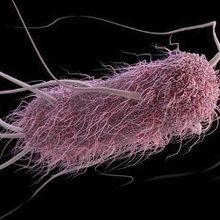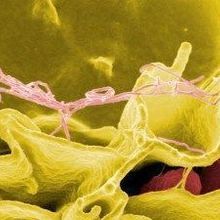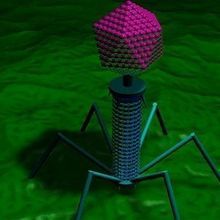bacteriophage

Switch Master: A Profile of Barbara Meyer
Diana Kwon | Jan 13, 2020 | 9 min read
Working with bacteriophages and nematodes, the University of California, Berkeley, molecular biologist uncovered a role for genetic switches in early development.

Infographic: Phage Protein Helps E. coli Evade Mouse Immune Cells
Catherine Offord | Jan 13, 2020 | 1 min read
Researchers suggest the viruses can help endosymbiotic bacteria get along with their hosts.

Opinion: We Need More than New Antibiotics to Fight Resistance
Neil S. Greenspan and Arturo Casadevall | Nov 1, 2019 | 3 min read
Metabolic disrupters, phages, and other approaches are going to be needed to treat the broadest possible range of patients infected by bacterial pathogens resistant to multiple drugs.

Genetically Modified Viral Cocktail Treats Deadly Bacteria in Teen
Ashley Yeager | May 8, 2019 | 2 min read
Tweaking the genomes of two phages and combining them with a third phage helped to clear a persistent Mycobacterium infection in the patient.

Researchers Discover 10 New Immune Systems in Bacteria
Jim Daley | Jan 25, 2018 | 3 min read
The findings more than double the number of known defense mechanisms, piquing the interests of molecular biology tool developers.

Image of the Day: Virus Spacecraft
The Scientist and The Scientist Staff | Jan 5, 2018 | 1 min read
Researchers reconstruct images of a virus that infects Escherichia coli bacteria.

Bacteriophages to the Rescue
Emily Monosson | Jul 16, 2017 | 3 min read
Phage therapy is but one example of using biological entities to reduce our reliance on antibiotics and other failing chemical solutions.

Book Excerpt from Natural Defense
Emily Monosson | Jul 16, 2017 | 3 min read
In Chapter 3, “The Enemy of Our Enemy Is Our Friend: Infecting the Infection,” author Emily Monosson makes the case for bacteriophage therapy in the treatment of infectious disease.

Anti-CRISPR Protein Reduces Off-Target Effects
Diana Kwon | Jul 12, 2017 | 3 min read
AcrIIA4, an inhibitor protein from the Listeria bacteriophage, can block DNA from binding to Cas9 during genome editing.

Ancient Protein Helps E. coli Thwart Viral Attack
Ashley Yeager | May 9, 2017 | 3 min read
When engineered to use a four-billion-year-old version of the protein thioredoxin, the bacteria can stall bacteriophage replication, a new study shows.

Inflammation Drives Gut Bacteria Evolution
Ruth Williams | Mar 16, 2017 | 3 min read
Viruses within Salmonella rapidly spread genes throughout the bacterial population during a gut infection, scientists show.

Scientists Identify a Viral Communication System
Joshua A. Krisch | Jan 19, 2017 | 2 min read
A team finds that viruses can sense chemical signals and use them to decide whether to kill or infect their hosts.

Keeping CRISPR in Check
Anna Azvolinsky | Dec 14, 2016 | 3 min read
In bacteriophage genomes, researchers find three anti-CRISPR proteins that naturally inhibit CRISPR-Cas9 in one bacterial species and can do the same in human cells.

Phages Carry Antibiotic Resistance Genes
Abby Olena, PhD | Dec 7, 2016 | 2 min read
Researchers find evidence of antibiotic resistance genes in the DNA of viruses that infect bacteria.

Black Widow Secrets in Phage Genome
Jef Akst | Oct 12, 2016 | 2 min read
In the DNA of the WO phage, which infects arthropod-inhabiting Wolbachia, researchers find sequences related to a black widow spider’s toxin and other animal genes.

Promoting Protein Partnerships
Ruth Williams | Sep 1, 2016 | 3 min read
Scientists generate new protein-protein interactions at an impressive PACE.

Timothy Lu: Niche Perfect
Kerry Grens | May 1, 2016 | 2 min read
Associate Professor, Departments of Electrical Engineering & Computer Science and Biological Engineering, MIT. Age: 35

Lu on Syn Bio
The Scientist | Apr 30, 2016 | 1 min read
MIT researcher and Scientist to Watch Timothy Lu talks about the value of cross-disciplinary approaches in bringing synthetic biology into the clinic.

Viral Soldiers
Jyoti Madhusoodanan | Jan 1, 2016 | 10+ min read
Phage therapy to combat bacterial infections is garnering attention for the second time in 100 years, but solid clinical support for its widespread use is still lacking.

Genome Digest
Amanda B. Keener | May 21, 2015 | 4 min read
What researchers are learning as they sequence, map, and decode species’ genomes
